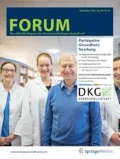Zusammenfassung
Aufgrund der kritischen Prognose vieler Krebserkrankungen sind palliative Zielsetzungen ein wichtiger Bestandteil jeder onkologischen Behandlung und Begleitung bei Patienten mit fortgeschrittenen Tumorerkrankungen. Wo im individuellen Fall palliativmedizinischer Behandlungsbedarf besteht, ist Gegenstand kontinuierlicher Forschung in der Palliativmedizin. Die Arbeitsgemeinschaft Palliativmedizin (APM) möchte sich zunächst der Frage widmen, wo im Besonderen Versorgungslücken für Palliativmedizin in der Onkologie bestehen. Mit dem Ziel, diese Lücken sinnvoll zu schließen, möchte die APM palliativmedizinische Konzepte und Fragestellungen weiter in die onkologische Forschung und Versorgung integrieren. Dazu wurden zunächst 5 Handlungsfelder definiert, für die Zielkriterien und Endpunkte entwickelt werden sollen. Diese umfassen 1) körperliche Symptome, 2) psychosoziale Ressourcen, 3) Therapieziele, 4) Organisation der Versorgung und 5) Belastung durch die Krebsbehandlung. Zur Erfassung und Messung dieser Zielkriterien speziell im Kontext interdisziplinärer Tumortherapie sollen entsprechende Instrumente selektiert, adaptiert oder, falls notwendig, auch neu entwickelt werden. Ziel der APM ist es, die behandelnden multiprofessionellen Teams und die klinischen Forscher in der Onkologie für palliativmedizinische Fragestellungen zu sensibilisieren und schrittweise die Datenlage sowie die Versorgungsqualität im Bereich Palliativmedizin in der Onkologie anzuheben.
Abstract
Due to the critical prognosis of many cancers palliative goals are an integral part of patient care in oncology. To define the need for specific palliative treatment in an individual patient is the subject of continuous research in palliative medicine. To start with the Working Group on Palliative Medicine (Arbeitsgemeinschaft Palliativmedizin, APM) wants to detect gaps in the continuous palliative care of cancer patients in the German health care system. In order to fill these gaps the APM aims to enforce the integration of palliative care concepts and topics in oncology research and standard care. This is to be reached by defining five spheres of activity in which the aim is to develop specific goals and study endpoints. These spheres are (1) physical symptoms, (2) psychosocial resources, (3) the definition of treatment goals, (4) the organization of palliative care and (5) the burden of cancer treatment. It is necessary to select, adapt and potentially develop tools for observing and measuring these goals and endpoints in the context of multidisciplinary cancer care. It is the objective of the APM to sensitize health care professionals involved in oncology patient care and research for the specific questions and endpoints in palliative medicine as well as to strengthen the quality of care and scientific evidence for palliative medicine in oncology.
Literatur
Robert Koch-Institut und Gesellschaft der epidemiologischen Krebsregister e. V. (2010) Krebs in Deutschland 2005/2006. Häufigkeiten und Trends, 7. Ausg. Eigenverlag, Berlin
Temel JS, Greer JA, Muzikansky A et al (2010) Early palliative care for patients with metastatic non-small-cell lung cancer. N Engl J Med 363:733–742
Gaertner J, Wolf J, Ostgathe C et al (2010) Specifying WHO recommendation: moving toward disease-specific guidelines. J Palliat Med 13:1273–1276
Weissman DE, Meier DE (2011) Identifying patients in need of a palliative care assessment in the hospital setting: a consensus report from the Center to Advance Palliative Care. J Palliat Med 14:17–23
Peppercorn JM, Smith TJ, Helft PR et al (2011) American Society of Clinical Oncology statement: toward individualized care for patients with advanced cancer. J Clin Oncol 29:755–760
Smith TJ, Temin S, Alesi ER et al (2012) American Society of Clinical Oncology provisional clinical opinion: the integration of palliative care into standard oncology care. J Clin Oncol 30:880–887
Zimmermann C, Riechelmann R, Krzyzanowska M et al (2008) Effectiveness of specialized palliative care: a systematic review. JAMA 299:1698–1709
El-Jawahri A, Greer JA, Temel JS (2011) Does palliative care improve outcomes for patients with incurable illness? A review of the evidence. J Support Oncol 9:87–94
Braga S (2011) Why do our patients get chemotherapy until the end of life? Ann Oncol 22:2345–2348
Danksagung
Die Autoren danken Herrn Dr. Alt-Epping, Göttingen, der stellvertretend für die AG Forschung der Deutschen Gesellschaft für Palliativmedizin das Manuskript gegenlas und durch seine kritisch-konstruktiven Kommentare wichtige weitere Denkanstöße gab.
Interessenkonflikt
Der korrespondierende Autor gibt für sich und seinen Koautor an, dass kein Interessenkonflikt besteht.
Author information
Authors and Affiliations
Corresponding author
Additional information
F. Lordick ist Sprecher der Arbeitsgemeinschaft Palliativmedizin (APM) der Deutschen Krebsgesellschaft (DKG); B. v. Oorschot ist stellvertretende Sprecherin der APM.
Rights and permissions
About this article
Cite this article
Lordick, F., van Oorschot, B. Palliativmedizin in der Onkologie. Forum 27, 367–371 (2012). https://doi.org/10.1007/s12312-012-0838-0
Published:
Issue Date:
DOI: https://doi.org/10.1007/s12312-012-0838-0

